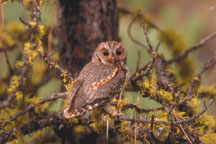|
Habitat Atlas for Wildlife at Risk
Flammulated Owl
Otus flammeolus

Flammulated
Owl
|
- A tiny owl; length 15 cm, weight 50 -
65 gm.
- Colouration makes these owls blend in with surroundings:
mottled grey with reddish-brown markings.
- Eyes are dark brown, most other small owls have
yellow eyes.
- Usually heard more often than seen;
call is a soft "boo-boot."
- Short 'ears' are actually tufts of feathers on
top of their heads; real ears are hidden.
Habitat map not available.
Status:
British Columbia Blue List
Canada: Vulnerable
Special Significance
In British Columbia, Flammulated Owls are restricted
to a narrow range of habitat in old Douglas-fir and
ponderosa pine forests, where large trees provide
foraging sites, snags provide nesting sites and thickets
of young trees provide roosting cover. Flammulated
Owls have a low reproductive rate and their long
migrations likely result in high annual mortality
of young birds. They nest in cavities, using holes
in dead snags made by Northern Flickers and Pileated
Woodpeckers. Modern forestry methods have eliminated
snags over much of this species' range. Flammulated
Owls are locally common in areas of spruce budworm
infestations, and may have an important role in the
control of some forest insect pest species.
Distribution
- In British Columbia, Flammulated Owls breed in the Southern Interior
from the East Kootenays west to Princeton, Merritt
and Lillooet, north to Williams Lake, Kamloops and Radium Hot Springs.
- Flammulated Owls breed in suitable habitat throughout
the montane forests of western North America and
Mexico; northern populations migrate to Mexico and Central America
during the winter
months.
- They are found between 500 and 1000 m elevation in
British Columbia.
Habitat
- Typical habitat is a mature Douglas-fir forest with scattered
large ponderosa pines, grassy openings, thickets of young trees,
and an
abundance of dead snags.
- Large, old trees are used for foraging and advertising
territory by calling.
- Snags with woodpecker cavities are required for nest
sites.
- Thickets of young trees, especially young Douglas-firs,
are important roosting habitat.
Reproduction
- Nesting occurs from early June to early August; nest is in a woodpecker
cavity with no other material added.
- Two to four eggs are laid.
- Eggs are incubated by females for 21 to 22 days; young
are ready to leave the nest 20 to 26 days after
hatching.
Food Habits
- Flammulated Owls eat insects, especially moths, beetles, grasshoppers
and crickets.
- One owl found in Kelowna had eaten a dusky shrew, the
only record of a Flammulated Owl eating a mammal.
Interesting Facts
- Flammulated Owls readily accept nest-boxes for nest sites. Boxes
should be 50 cm high, 20 cm square, with a 7 cm hole
near the top.
- Young birds leave the nest before they can fly well
and when they are still covered with grey down;
they give a gasping call to beg foods from the adults.
- Flammulated means 'little flames,' referring to the
line of orange feathers down the back.
Threats
- Habitat loss due to forest harvesting.
- Destruction of nest sites during logging operations.
- Small size of this owl makes it vulnerable to attack
by nest-site competitors such as squirrels.
Management Considerations
- Protect remaining old-growth ponderosa pine
and Douglas-fir forests.
- Leave snags and some large pines and firs when
selectively logging a site; this can be
done by choosing wildlife tree patches that contain
suitable nesting snags.
- Set up nest boxes in forests that have few
or no suitable nest sites.
- Contact your local B.C. Ministry of Water,
Land and Air Protection to report a sighting
of Flammulated
Owls.
|
References
1. van Woudenberg, A. 1998. Status of the Flammulated Owl (Otus flammeolus)
in British Columbia. Draft status report, Ministry of Water, Land
and Air Protection, Williams Lake, BC.
2. McCallum, D. A. 1994. Flammulated Owl. In The Birds
of North America No. 93 (A. Poole, P. Stettenheim and F. Gill, eds.).
Philadelphia: The Academy of Natural Sciences; Washington, DC: The
American Ornithologists' Union.
3. Cannings, R. A., R. J. Cannings and S. G. Cannings.
1987. The birds of the Okanagan Valley, British Columbia. Royal British
Columbia Museum, Victoria. 420 pp.
|